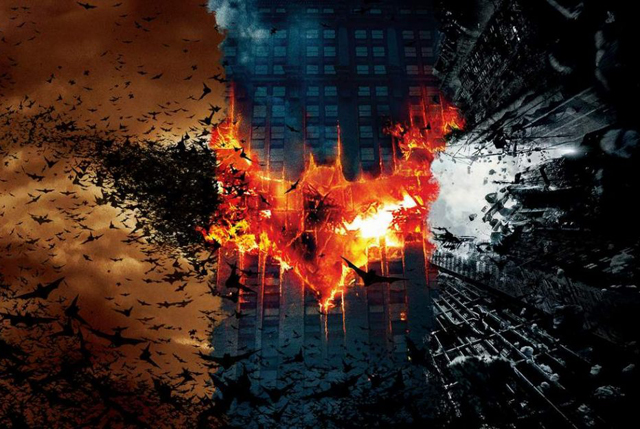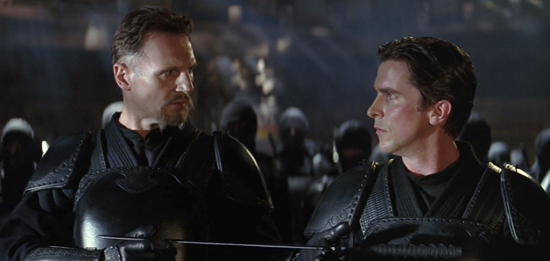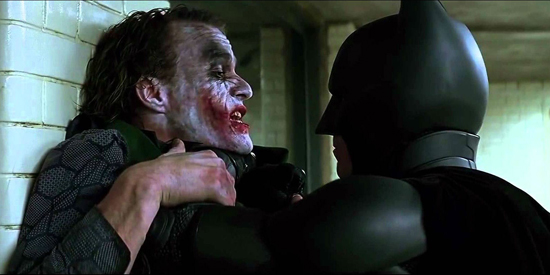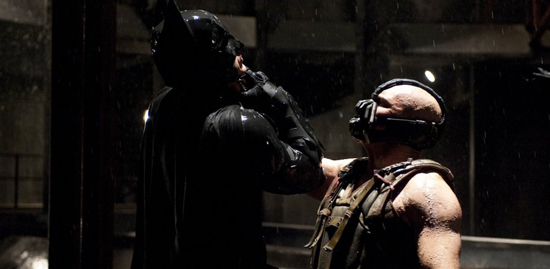
Before Marvel Studios set a new high standard for the super hero genre, and before DC Comics would constantly fall short of that standard as they’ve tried to keep up with their rival, there was only one true leader of the pack, and his name was Batman. This was evident with the creation of what we know now as the Dark Knight trilogy, which was spearheaded by one of cinema’s most daring filmmakers in recent memory, Christopher Nolan. He arrived on the scene at just the right moment for both the character and the super hero genre in general. Both had reached somewhat of a low point in 1997 with the release of the disastrous Batman & Robin; a movie that many had considered a franchise killer. Indeed, it took 8 years for Batman to recover from this low point, and the reigns to the series passed through many hands, including auteur Darren Aronofsky, before ultimately landing in Nolan’s lap. And Nolan gave the character the revival he desperately need. Perhaps the first thing one will praise about Nolan’s approach is that he grounded the character back into a real world setting. Gone were the campy flourishes of Tim Burton and Joel Schumacher, and instead we were presented with a gritty reality that made the whole thing feel as plausible as a super hero movie could be. But, one thing that I find so fascinating about Christopher Nolan’s trilogy is how well it tells the story of it’s main hero. We delve deeper into the man that Batman is more than in any other previous version, guided by an “almost” always compelling performance by Christian Bale in the role (the voice could have been a little better). In these movies, we finally get an understanding of why a man would fight crime dressed up as a bat, and that in turn helps us to examine our own societal responses to tragedy and hardship. One of the larger themes that Nolan addressed in his movies is the effect of terrorism on societies, manifested through some of the iconic villains in Batman’s rogues gallery, and how the lines between good and evil get blurred under the guise of achieving justice. Quite a hefty shift for this series to take, and one that has in turn made these three movies modern day classics and benchmarks for the genre as a whole.

BATMAN BEGINS (2005)
It’s surprising that up until this point, Batman’s origins had never been fully explored on the big screen. Sure, his origins were alluded too in previous films, particularly with the essential element of his parent’s murder (which is also recreated again here too), but the actual details of Bruce Wayne’s road towards becoming the Bat had never been presented before. Taking inspiration from Frank Miller’s graphic novel, Batman: Year One (1987), Batman Begins fills in those gaps between young Bruce’s loss of innocence to his ultimate donning of the cape and cowl. And it proves to be a compelling story on it’s own; to the point where you don’t even care that Batman doesn’t make his first appearance until 80 minutes into a 2 1/2 hour movie. We see Bruce Wayne receive his training in the ninja arts taught to him by the mysterious League of Shadows. There he is mentored by Liam Neeson’s Ra’s Al Ghul , who instills in him the idea that he must become more than a man to help stop crime in his home of Gotham City; he must become a symbol, and as a symbol, he can inspire the downtrodden and bring fear to the merciless. This conflict between acting as a symbol and what cost that leaves on the man is a primary theme that Christopher Nolan would explore through all three Dark Knight films, but it’s foundation is laid out perfectly here in the first film. We see how Batman’s moral code is set, choosing to fight crime just short of taking a life, and how that sets him apart from the other extreme characters who will populate his city as the story unfolds. Nolan also gives us the added pleasure of watching Bruce Wayne build up the arsenal, with the help of his ever loyal butler Alfred (a delightful Michael Caine) and the resourceful Lucius Fox (Morgan Freeman). He even manages to answer the age old question, “why bats?” And the simple answer is, bats frighten him, and he wants to turn that fear around and make it the thing his enemies will fear.
The theme of fear would also prove an important element that would play out through the entire trilogy, and there was no better way to lay the groundwork for that piece than to embody it through an adversary whose whole identity revolves around it; the Scarecrow, played in a scene-stealing performance by Cillian Murphy. His Dr. Jonathan Crane is a simplified version of the often caricatured villain from the comic books, but he’s nevertheless effective in this story, and is often creepy enough without the mask he dons for the persona. What I appreciate is the fact that Christopher Nolan didn’t try to jump right in and revisit already established Batman villains for his movie (at least not right away). Here he managed to elevate a lesser known villain from the comics and show that you didn’t need to make your baddies a freak show in order to make them memorable in your movie. The same likewise goes for Neeson’s Ra’s Al Ghul. A dramatic departure from the immortal antagonist from the comics, Ra’s purpose in this film is still no less effective in presenting a compelling threat to Batman and Gotham. Ra’s Al Ghul begins for the series the continuing threat of terrorism that Batman will always be up against. His terrorist ideals are based primarily around eco-centric philosophy, see himself and the League of Shadows as the ones who bring balance to the world once a major population center grows out of control, in this case Gotham. And to destroy the city, their weapon as it turns out is fear itself, weaponized through Scarecrow’s toxic gas. Through all this, Nolan perfectly touches upon heady themes, while at the same time making it a rousing adventure true to it’s comic book origins. Up until the MCU began, this was widely seen as the greatest comic book origin movie ever made, and it still is one of the best. I myself named it as my favorite film of the year 2005. But, little did we know that Nolan had much more tricks up his sleeve in the years ahead.

THE DARK KNIGHT (2008)
If Batman Begins made for a fantastic overture, this would end up being the magnum opus. Here we have the reason why this series is dubbed the Dark Knight trilogy. Interesting enough, Christopher Nolan never initially planned to make a sequel to Batman Begins, let alone a trilogy. He was already completing his next film The Prestige (2006) and had Inception (2010) waiting in the wings. But, the success of Begins was enough to convince him to return, and this time with the full support of the Warner Brothers studio behind him. A little sight gag in the closing minutes of Begins, where Detective Jim Gordon (Gary Oldman) presents him a calling card of a criminal he should look into, which turns out to be a Joker card, easily gave Nolan the stepping stone for where to go next. But, what ended up happening in the process proved to be very interesting. For one thing, Nolan made one of the boldest casting choices in movie history by tapping heartthrob actor Heath Ledger in the iconic role of the Joker. Many comic book fans were initially outraged by the choice, believing that Ledger was completely wrong for the character, but by the time the movie came out, all those naysayers would be silenced forever. Heath’s performance as the Joker was not only perfect, it was transcendent. His Joker is not only the most compelling villain we’ve ever seen in this genre, he may very well be one of the greatest screen villains of all time; in the same league as Hannibal Lecter and Norman Bates. Watching him work of Christian Bale’s Batman especially provides some of the best moments in the movie, including the now iconic interrogation scene. Mainly due to Ledger’s Joker, this movie has enjoyed the lofty reputation it has had over the years; topping many critics’ favorite films lists and often being considered the best film of it’s genre. It even sparked the Academy Awards to change it’s rules, after it was snubbed for Best Picture, expanding it’s number of nominees beyond the limit of 5 per year. Ledger’s performance did earn him a much deserved Oscar, but sadly it was a posthumous win as the actor died tragically before the film’s release.
But The Dark Knight is more than just a showcase for Heath Ledger’s Joker. Nolan treated us to not only one iconic Batman villain in his film, but two. Harvey Dent, aka “Two-Face”, is also featured here, and is in many ways it’s a cinematic redemption for the character. After his terribly botched appearance in Batman Forever (1995), where he was played in a campy performance by an embarrassing Tommy Lee Jones, Two-Face finally gets an origin in this film that’s truer to his persona from the comics. Played with excellent restraint by Aaron Eckhart, Harvey Dent represents the fine line that separates characters like Batman and the Joker. He is at heart a good man with a conscience, but also flawed because of his temper. And in the movie, we see how even good men can turn bad so easily as a horrific accident scars him physically, making him more susceptible to the Joker’s mental manipulation. It’s a fine line that we also see Batman having to cross at one point too. In order to track down the Joker, Batman uses cellular technology created by Lucius Fox to basically spy on every citizen in Gotham City, an ethical line that Fox is deeply troubled by. At this point, we see how easily Batman can also be turned evil, as desperation has forced him into a situation where he has to abuse his power in order to win the day. This brings us back to the overarching theme of the effect that terrorism has on society, and in Dark Knight, we see the most profound examination of this. In the years after 9/11, the United States made many morally questionable decisions in the name of combating terrorism, and those same dilemmas strongly influenced the themes in Nolan’s Dark Knight films. The Joker is a threat unlike anything else that Batman will ever face, one whose villainy has no rhyme or reason; someone who as Alfred puts it, “just wants to watch the world burn.” So, to combat an agent of chaos like that, is it possible to fight back without becoming a villain yourself? That’s the brilliantly delivered question behind Nolan’s The Dark Knight, and it’s matched with a truly epic sized presentation. This was Nolan’s first foray into IMAX film-making, which is masterfully put to use in some amazing scenes like the opening bank robbery and the semi-truck chase halfway through the film. It’s a movie that really earns that masterpiece mantle.

THE DARK KNIGHT RISES (2012)
So, where do you go next after that? That’s the dilemma that Christopher Nolan was tasked with after The Dark Knight. The movie was an international phenomenon, and at the time, a record setting film in the super hero genre. Not only that, but Christopher Nolan had built his reputation further as an unmatched cinematic artist of high ambition, with his popularity soaring after making The Dark Knight and Inception back to back. Naturally, the need for another film to round out the trilogy was going to happen, especially with the cliffhanger ending of Dark Knight. But the question remained, what was it going to be about? You couldn’t revisit the Joker nor Two-Face again, so who was a big enough villainous presence to follow in the footsteps of those two? Nolan eventually got the inspiration from his co-story writer David S. Goyer to take a look at an often under-utilized villain from the comic books; Bane. This was somewhat of an odd choice, given how the steroid enhanced muscular adversary didn’t lend himself well to Nolan’s more grounded style, but the way they re-imagined the character actually proved to work to their advantage. Gone were the luchadore style mask and plastic tubes that feed venom into his muscles making them grow huge, and instead we got natural muscles and a grotesque, face-hugging mask covering his mouth to define the character. The right kind of actor was needed, and Nolan once again made a brilliant choice in giving the role to his Inception scene-stealer, Tom Hardy. Hardy had the physical build perfect for the role, but it’s in the vocal performance where he truly makes the character shine. Hardy’s Bane has a commanding presence, delivering several long soliloquies with absolute confidence, made all the more remarkable as he is left to perform with his mouth completely covered, relying more on his eyes and body language to do the heavy lifting. Through all this, he becomes a threat to Gotham of a different type; a zealot bent on destruction. Before, Batman had to deal with threats to his ethics and his soul; now it’s his threshold of pain that is challenged, and it may be one that will determine whether or not a Batman will survive.
The Dark Knight Rises is the most polarizing of the movies in this trilogy. Some people felt that it was a let down after The Dark Knight, with many complaints stating that it had too convoluted of a plot, and that many of the changes that Christopher Nolan made were unfaithful to the essence of the characters and the legacy of what came before it. But I found myself to be in the camp of people who outright loved this movie, and believed that it was a perfect conclusion to this particular story. I believe that to really appreciate this film, you have to look at it’s context within the full arc of the trilogy as a whole. The Dark Knight Rises closes out many of the grander themes that were laid out in Batman Begins and followed through with The Dark Knight, and that the toll that fighting back against evil takes on a person both spiritually and physically. One thing that culminates in this film is the sense that by becoming Batman, Bruce Wayne has essentially been fighting back an internal struggle that has been damaging his mind slowly over the years, and that’s the fact that he never was able to cope with that loss of innocence as a child. He has essentially killed off who Bruce Wayne was, and by becoming Batman, he is in turn welcoming death, a weakness that Bane is all too happy to exploit. In a triumphant scene at the end of the second act, Bruce Wayne must climb out of an underground prison, and to do so, he must fear death once again, which means that he must have something to live for. When he does, he doesn’t rise up as Batman, but as Bruce Wayne reborn. And thus, we get a satisfying arc to the character of Bruce Wayne. The entire trilogy is about him, not Batman. With Dark Knight Rises, Nolan poignantly illustrates how a man can find purpose again by letting go of the pain that he once thought empowered him. Perhaps many people didn’t like the fact that the movie concludes with Bruce giving up the Bat in order to live a normal life, and passing it on to a worthy successor, Robin (played by Joseph Gordon-Levitt). But the arc of the story was meant to show the power of moving beyond pain by embracing life, something which culminates perfectly the themes of all three films. Sure it’s not a perfect movie; Anne Hathaway’s Catwoman is kinda shoehorned in, despite a fine performance. For me, it was a grand epic finale to one of the finest tales ever told in the mythic super hero genre.
One thing that I do love about the Dark Knight trilogy as a whole is the fact that it is a complete story. There’s no grander cinematic universe beyond it’s narrative; no setting up of multiple franchises with Easter eggs or winking nods. It’s just Batman, Gotham City, and the rogues gallery that means to terrorize them. The whole thing is a story told in three acts, with Bruce Wayne working through a soul-searching journey to define himself. Along the way, he faces foes that are not only great threats to him and his city, but also existential threats that force him to reconsider the kind of person he wants to be. In Ra’s Al Ghul, Joker, Two-Face, and Bane, Bruce Wayne sees variations of the kind of person that he could easily have become had he made different choices throughout his life. I believe that’s it was essential that these had to be the villains of this trilogy, as opposed to more conventional choices like The Penguin or The Riddler. In each of them, we see the dark side of Batman manifested whole. Ra’s Al Ghul is a Batman who believes killing is justifiable; Joker is a Batman with no moral code, working in the exact opposite direction as an symbol of chaos rather than order; and Bane is a Batman made a slave to a twisted ideology, believing right and wrong are irrelevant. In a perfectly stated opinion from Harvey Dent in The Dark Knight, he says, “You either die a hero, or you live long enough to see yourself become the villain.” It’s a foreshadowing statement about himself, of course, but it could also apply to Batman as well. He is ever so close to becoming a villain himself in these movies and the same can be true about all of us in our own lives as well. That’s the greatest aspect about the Dark Knight trilogy; the ethical questions it leaves us about the true nature of justice, and whether or not symbols like Batman are as pure as we like to think they are. Batman ultimately remains a hero by the end, but Christopher Nolan makes it clear in his trilogy that not every path taken is as morally clear cut one. It’s a trilogy that will go on to remain one of the genre’s most triumphant, and also one of the most daring in all of cinema. Whether you go in entranced by Heath Ledger’s mesmerizing performance as the Joker, Nolan’s unparalleled sense of epic scale, or just the sheer delight of watching the gritty bare-knuckle fight between Batman and Bane, this is a trilogy of classics that gives the Dark Knight true cinematic honor.